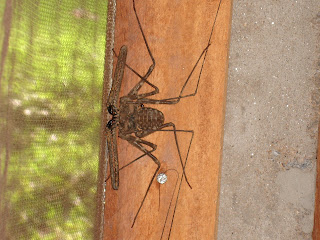Big Bug
If any of you were wondering exactly what that big bug was I sent off a few weeks ago... here it is. Wikipedia says 5 to 40 mm but from the picture of it shows a the head of a 16 penny nail. I would venture to say that this monster was about 150 mm. I have been taking pictures of cool bugs and other wildlife and have quite a collection. Some of the things we see here are quite astonishing.
From Wikipedia, the free encyclopedia
Scientific classification
Kingdom: Animalia
Phylum: Arthropoda
Class: Arachnida
Order: Amblypygi
Amblypygi is an order of invertebrate animals belonging to the class Arachnida, in the subphylum Chelicerata of the phylum Arthropoda.
Amblypygids are also known as tailless whip scorpions (see also whip scorpion).
The name "amblypygid" means "blunt rump", a reference to a lack of the telson ("tail") carried by related species.
As of 2002, approximately 5 families, 17 genera and 136 species have been described. They are found in tropical and subtropical regions worldwide. Some species are subterranean; many are nocturnal. During the day, they may hide under logs, bark, stones, or leaves. They prefer a humid environment.
Amblypygids may range from 5 to 40 mm. Their bodies are broad and highly flattened and the first pair of legs (the first walking legs in most arachnid orders) are modified to act as sensory organs. (Compare solifugids, uropygids, and schizomids.) These very thin modified legs can extend several times the length of body. They have no silk glands or venomous fangs, but can have prominent pincer-like pedipalps.
Behavior
Amblypygids often move about sideways on their six walking legs, with one "whip" pointed in the direction of travel while the other probes on either side of them. Prey are located with these "whips", captured with pedipalps, then masticated with chelicerae.
Courting rituals involve the male guiding the female with his pedipalps over spermate deposited into one or more sperm masses. She gathers the spermate and lays fertilized eggs into a sac carried under the abdomen. When the young hatch, they climb up onto the mother's back; any which fall off before their first molt will be eaten by the mother.
Amblypygids, particularly the species hrynus marginemaculatus and Damon diadema, are thought to be one of the few species of arachnids that show signs of social behavior. Research conducted at Cornell University by entomologists suggests that mother amblypygids comfort their young by gently caressing the offspring with her feelers. Further, in an experiment where two or more siblings were placed in an unfamiliar environment, such as a cage, they would seek each other out and gather back in a group.[2]


0 Comments:
Post a Comment
<< Home